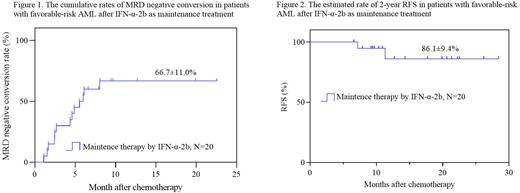Abstract
Background: Maintenance therapy in favorable-risk is still controversial, so the maintenance therapy of AML is of great concern. Interferon-α (IFN-α), a type Ⅰ IFN, is a well-known antitumor agent, which has an immunoregulatory function. Several studies have shown that IFN has a definite therapeutic effect on AML. Indeed, studies have reported that IFN-α as maintenance therapy in patients with AML can prevent leukemic relapse. However, the only randomized controlled trial (RCT) that explored the role of IFN-α as maintenance therapy in AML found no difference between the comparison groups in remission duration, overall survival (OS), disease-free survival (DFS) or relapse-free survival (RFS). In our previous respective studies, IFN-α-2b as a maintenance therapy may reduce the relapse rate in patients with favorable-risk AML after consolidation chemotherapy. Moreover, IFN-α-2b could effectively control minimal residual disease (MRD) in acute leukemia/myelodysplastic syndrome after allogeneic hematopoietic stem cell transplantation (HSCT). The aim of this study was to evaluate the efficacy and safety of IFN-α-2b in the maintenance of favorable-risk AML.
Method: This is an interim analysis of an ongoing clinical prospective study (trial registration number: ChiCTR2000035310) of a planned 31 favorable-risk (NCCN Guideline) AML patients with MRD positive who underwent 1-2 therapeutic induction chemotherapy for complete hematologic remission (CR) and completed 4-6 courses of consolidation chemotherapy. MRD positive was defined as detectable MFC-MRD >0.1% or fusion genes level decreased by >3 log. 22 patients were recruited in our study to date. Patients were administered with 3 million U of IFN-α-2b three times a week for 18 months. Bone marrow assessments were performed on the 2nd, 5th, 8th, 11st, 14th, 18th month since IFN-α-2b therapy. The primary objective is to determine the cumulative rates of MRD negative conversion, 3-year RFS and adverse reactions.
Results: Patients were classified as favorable-risk category according to cytogenetics and molecular biology. 22 participants with favorable-risk AML were enrolled in this study, and 2 of them received IFN-α-2b less than 3 months, who were not evaluated in this report. The molecular biological characteristics of this study were AML-ETO+/c-KIT- 11 cases; AML-ETO+/c-KIT+ 2 cases (T417_D419delinsIP); CBFβ-MYH11+/C-KIT- 5 cases; CBFβ-MYH11+/C-KIT+ 2 cases (Y418_D419insFF, D816Y); NPM1+/FLT3-ITD- 3 cases; and CEBPA double mutation 1 case. The median age of the 22 participants was 47.5 (18.0-66.0) years old. Outcome data were updated as of July 2022, for a median follow-up 13.5 (6.6-24.0) months of the 20 patients received IFN-α-2b more than 3 months, and the median duration of treatment was 13.5 (5.2-18.0) months. Among 20 evaluated patients, the cumulative rates of MRD negative conversion is 66.7±11.0% after the median time of 4.4 (1.1-8.1) months IFN-α-2b treatment (Figure 1). As for recurrence, 2 patients had hematologic recurrence, with the estimated rate of 2-year RFS was 86.1±9.4% (Figure 2). Meanwhile, there are 5 persistent MRD positive participants, 3 of them got decreased MRD level for 1 log-fold, 1 case got increased MRD level for 2 log-fold, and MRD level did not decline in 1 case.
The regimen was well tolerated. In terms of safety, the most frequent nonhematologic adverse events were fever (11/20, 55.0%) after IFN-α-2b therapy. 4/20 (20.0%) developed hematologic toxicity which were thrombocytopenia, 1/20 (5.0%) had muscle pain, 1/20 (5.0%) elevated hepatic transaminases, 1/20 (5.0%) developed rash.
Conclusion: IFN-α-2b as maintenance therapy for CR1 patients with favorable-risk AML gain a high rate of MRD negative conversion and high rate of 2-year RFS Interferon therapy is safe and well-tolerated.
Disclosures
No relevant conflicts of interest to declare.
Author notes
Asterisk with author names denotes non-ASH members.


This feature is available to Subscribers Only
Sign In or Create an Account Close Modal